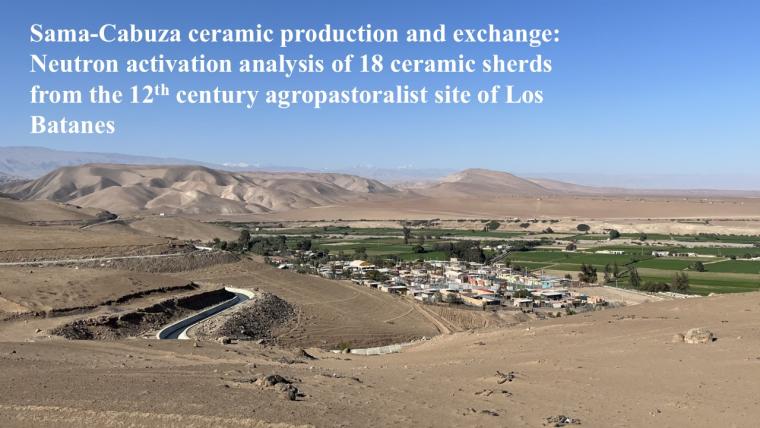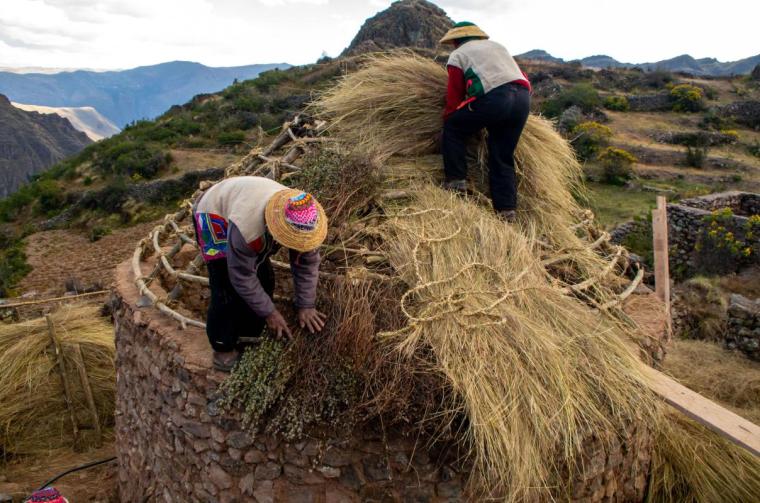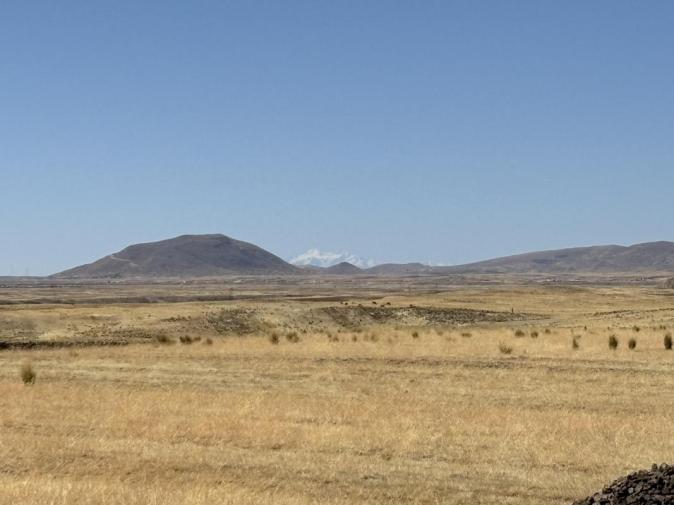Programa
A Village at the Crossroads: Pathways, Bridges, and Resettlement Landscapes in Colonial Jauja, Peru
This essay joins a wave of new studies regarding colonial reducciones by bringing the Jauja Valley into the conversation. Using a combined methodology of deep archival research to make up for the missing visita records and intensive field-walking archaeological surveys associated with the early reducciones, we will show that, within a single valley, and in response to local conditions, two distinct solutions were gradually applied to the problem of resettlement, generating two distinct reducción landscapes. One required reusing previous settlements; the other, building in unoccupied spaces that, nevertheless were linked to roads, bridges, waystations, and indigenous forms of social organization. Thus, reducciones were both an old and a new phenomenon in the valley.
Afro-Andean and Indigenous Relations in Colonial Highland Communities and Workplaces
Afro-Andean and indigenous relations in highland communities and workplaces shaped colonial centers and their hinterlands like Cuzco and its surrounding productive zones and transportation networks stretching across the southern Andes. These interactions began from the very beginning of the Spanish incursions into the Andes, and they continued throughout the period of European domination. Significant areas of contact and cultural synthesis emerged and changed over time. The paper delineates some of the sites and sources for exploring this aspect of Andean History and culture.
Agua, comunidad y gobernanza: La memoria hidrosocial del Paisaje Arqueológico de la Meseta de Marcahuasi, San Pedro de Casta, provincia de Huarochirí (Lima-Perú)
Marcahuasi es una meseta volcánica habitada en el Intermedio y Horizonte Tardío, donde las sociedades prehispánicas gestionaron el agua mediante cochas, facilitando actividades agro-pastoriles. Su paisaje arqueológico incluye asentamientos, espacios sacralizados y estructuras hídricas, reflejando una memoria hidrosocial que sobrevive en la comunidad local. Sin embargo, factores como migración, cambio climático y un turismo y gestión territorial inadecuados están deteriorando este patrimonio y memoria. Tras la pandemia, la comunidad de San Pedro de Casta ha buscado recuperar Marcahuasi mediante la construcción de cochas y la reorganización del turismo, enfrentando desafíos en la gobernanza de este patrimonio natural y cultural.
Archivos in/existentes: Recovering disappeared photographs from the epicenter of the Peruvian Internal Armed Conflict
CONSTRUCTING AND DISARTICULATING THE WORLD" LANDSCAPES, MEMORY, AND POWER IN CUZCO INKA: THE CASE OF CHAKAN
This lecture explores the construction and destructuration of social landscapes, at conceptual and material levels, linked to the memory and power of the elites of the Cuzco Valley during the Inka period through a study of the micro-basin of Chakan, located in the extreme northwest of the city. The social and religious implications of the landscape created by Hanan Cuzco are explored through the analysis of a colonial myth. The ritualized destructuration of the landscape is explored, based on the available archaeological record, thanks to excavations conducted at the Archaeological Complex of Chakan. The results support the presence of events of ritual abandonment of their ceremonial architecture, as material effects linked to the cosmogonic restructuration of the known world because of the Hispanic presence in the area, or as part of a more complex phenomenon of historical awareness and social change.
El recinto con forma en “D” en Santa Rosa de Pucalá: Integración Religiosa y dinamismo territorial en el valle de Lambayeque
Emergent Heads & Incipient Urbanism
Scholars working in the Lake Titicaca region are using new C14 dates to tease apart the timing of Tiwanaku. This work is resulting in new perspectives on the earliest phases of this urban center. Our current project uses visualization techniques to produce new knowledge about the Late Formative phases at "proto-urban" Tiwanaku. In this paper, we revisit the most well-known Formative space at Tiwanaku, the semi-subterranean temple. We present archival evidence, new photogrammetry results, and artistic renderings to query what is known and what remains uncertain about this under-examined enclosure.
Entendiendo los cambios en Magdalena de Cao: Empoderamiento femenino, turismo y valoración del pasado precolombino
Esta ponencia pretende presentar los resultados de un trabajo etnoarqueológico basado en una serie de entrevistas hechas con personas de la comunidad de Magdalena de Cao (Costa Norte del Perú). La intención del trabajo fue entender los impactos del descubrimiento de la líder Moche, Señora de Cao, en la ciudad. Las temáticas de interés fueron: los cambios urbanos, económicos y sociales; los impactos del turismo; los cambios en las relaciones de género; el empoderamiento femenino; las consecuencias en las prácticas chamánicas de la región y cómo los discursos promovidos por el Museo Cao tratan la identidad Moche.
Looking Beyond the Looting: Preliminary Excavations in the Southern Cemetery Sector of Chan Chan, Peru
The Chimú capital, Chan Chan, has been looted since Colonial times. Using drone imagery, we identified areas of the southern cemetery of Chan Chan with minimal evidence of looting. Excavations revealed a mix of contexts, including a relatively undisturbed domestic context and an in-situ camelid burial. Though no undisturbed human burials were recovered, one context contained remains of at least seven individuals and a near-complete ceramic shaped like a reed boat. We hypothesize this could represent a secondary ossuary context or a looting event that occurred prior to modern day, raising questions of placemaking and use of space over time.
My ancestor´s place, time, and size: The spatiotemporal grammar of mortuary landscapes in the Cordillera Blanca (Ancash, Peru)
CThis paper considers the spatial and temporal distribution of collective mortuary monuments on the western escarpment of the northern Cordillera Blanca to address the evolving role of ancestor veneration in social reproduction. The location of major necropoles is presented and linkages with the social organisation of irrigation farming considered. Relative placement and architectural stratigraphy of collective tombs -all invariably looted- are argued to indicate a preoccupation with places and paths in the landscape that articulate water management through rituals in which soundscapes and flowing water played major roles.
Patrimonio participativo pasqueño y la esperanza de arqueología-museología comunitaria: Los casos de las comunidades de Pallanchacra y Chaupimarca, Pasco, Perú
Comunidades campesinas en Pasco, Perú están movilizando su patrimonio arqueológico para crear nuevos caminos al desarrollo económico. Iniciativas comunitarias en monumentos prehispánicos ayudan a enfrentar una situación de precariedad social-ambiental causada por la contaminación minera de agua y el descuido institucional del estado. Durante nuestra colaboración peruano-estadounidense para excavar los sitios de Chawin Punta-Kunturay, y Guellayhuasin, hemos encontrado que pueblos quechuas como Pallanchacra y Chaupimarca promuevan sus propias formas de museología en monumentos y plazas de armas. Esas intervenciones indígenas hacen cuestionar desde que perspectiva se debe plantear las “mejores prácticas” para un patrimonio participativo pasqueño.
Pre-Inka Saqsaywaman and the Urban Origins of Inka Cusco
In June 2024, we began excavations in the Cruz Moqo Sector of Sacqsaywaman, the monumental acropolis of the Inka. We have synthesized the results of our preliminary excavations with unpublished technical reports that identify remains of Killke structures throughout Saqsaywaman. We conclude that Saqsaywaman marked a relatively dense settlement and note several remarkable continuities between Killke and Inka architecture. Our initial findings add weight to the arguments that “Killke” and “Inka” did not constitute two distinct ethnicities and that pre-imperial Cusco functioned as an important urban center.
Sama-Cabuza ceramic production and exchange: Neutron activation analysis of 18 ceramic sherds from the 12th century agropastoralist site of Los Batanes
Our analysis characterizes the chemical composition of Sama-Cabuza ceramics from Los Batanes (Sama Valley, Tacna) and explores the possibility of long-distance ceramic exchange networks among agropastoralists during the late Terminal Middle Horizon. We report on neutron activation analysis (NAA) data of 18 Sama-Cabuza ceramic sherds conducted at MURR’s archaeometry lab. Our results show considerable compositional variation within the sample from Los Batanes, suggesting a lack of standardization in resource procurement and technologies employed by the makers of Sama-Cabuza pottery. Additionally, two of the analyzed Sama-Cabuza-style sherds are chemically distinct from the rest of the samples, potentially indicating a non-local origin.
Sequential analysis and dating of yarn fragments from six Paracas mantles in bundle WK12-382
The Necrópolis de Wari Kayan at the Paracas site, in the coastal desert of south-central Peru, is a well-preserved mortuary complex of the late Formative/ initial Early Intermediate Period. Loose yarns from textiles of tomb 12 (bundle 382) were collected by Anne Paul in 1985 for dye analysis and dating. We currently sequence state-of-the-art analytic procedures to assess fiber and dye composition, radiocarbon age, and stable isotope fractionation values from a single yarn fragment. Six embroidered mantles from the outer bundle layer radically differ in their techniques, imagery, and colors. Do they represent different time periods or different producer groups?
Tejiendo los relatos de Pañamarca. Excavaciones en la Sala del imaginario moche
Untangling the chronological complexities of the Andean Central Coast Formative Period: A Bayesian reassessment
This study analyzes 190 radiocarbon dates from 13 Formative sites on the Andean Central Coast, Peru, and 59 dates from Chavín de Huántar using Bayesian methods via OxCal. The findings show the coexistence of Formative and Late Archaic sites, with a prevalent U-shaped architectural tradition peaking between 1500–1000 cal BC. A chronological hygiene framework categorizes dates into four reliability levels, leading to the development of four Bayesian models: Model Ancón, Model Mina Perdida, Model El Tanque, and Model Malpaso. This multi-model approach improves data reliability, facilitates comparative analysis, and refines interpretations of overlapping cultural phases.
Wankar Wasi Ruway: Making a Drum-Shaped House in the Sacred Valley (Cusco, Peru)
In the uplands of the Sacred Valley (Cusco), autochthonous groups constructed hilltop villages and thrived before and during consecutive Inka and Spanish colonial regimes. Studying rural built environments and construction techniques helps reconstruct non-state social organization, as well as resilience under state occupation. In Huama (Lamay District), community members have cultivated evolving architectural traditions since the pre-contact period. This poster presents the results of a collaborative, community-serving project that documented the construction of a wankar wasi (drum-shaped house). This work celebrates Huama’s history and traditional knowledge while illuminating the technological choices and relationships engaged in production practices, past and present.
With Great Care, Comes Great Responsibility: Using Tuberculosis in Bioarchaeology of Care Case Studies from Chiribaya Alta
The social implications of tuberculosis in the Andes is an understudied area of interest. Lorna Tilley’s bioarchaeology of care method provides a new way of approaching impairment and disability in past societies. Tilley's method contextualizes projected disease symptoms at the levels of the individual and their community. In this study, we use a bioarchaeology of care model for two individuals from Chiribaya Alta with skeletal indications of tuberculosis. It was determined that while some valuable information can be gleaned from certain paleopathological cases careful judgment must be employed when using the bioarchaeology of care method with tuberculosis.
Zooarchaeological Signals of Social Stratification : Faunal Analysis of the Archaic Burial Site of Kaillachuro (Lake Titicaca Basin, Peru)
The onset of social stratification during the Archaic period in the Lake Titicaca region has been the topic of recent debate. Zooarchaeological analysis can add another line of evidence to assess status through ritual sacrifice and feasting associated with funerary practices. Excavation of the burial site of Kaillachuro (5300-3000 BP), located inthe southern Lake Titicaca Basin (Peru), yielded a faunal assemblage of 1,978 bone fragments. Although the collection is heavily burned and highly fragmented, there is still much to discern from the assemblage. Most of the identifiable remains correspond to artiodactyls, of which, camelids and cervids are the highest-value wild game in the region. Evidence of processing and/or cooking is present in the form of spiral fractures and cutmarks on ~20% of the identifiable assemblage. Camelids comprise a much higher proportion (85%) of the identified artiodactyls than cervids (15%). These results add to previous isotopic data that reflects a human diet consisting mainly of C3 plants, with some meat. Human burial mounds associated with butchered and cooked camelid and cervid remains could be a signifier of the social capital these individuals had during their lives.
“RELACIONES INTERÉTNICAS Y GÉNERO EN LOS MATRIMONIOS ENTRE CÓNYUGES AFROANDINOS E INDÍGENAS EN EL CUSCO, 1650-1720”
Cusco’s 1650 earthquake profoundly modified social structures and the city’s physical appearance. Between 1650 and 1720, rural Cuzco urbanized. Disaster and reconstruction makes visible Afro-Andean presence and participation because reconstruction generated more documentation. They appear as active social participants, not just as enslaved people, employing different strategies to insert themselves in a majority indigenous society. They appear frequently in a series of social conflicts, especially in interethnic relations. Beginning with an intensive interrogation of the documentary sources, this paper re-interprets these relations and explores changing gender dynamics in marriages among Afro-Andean and indigenous spouses in Cusco, 1650- 1720.



